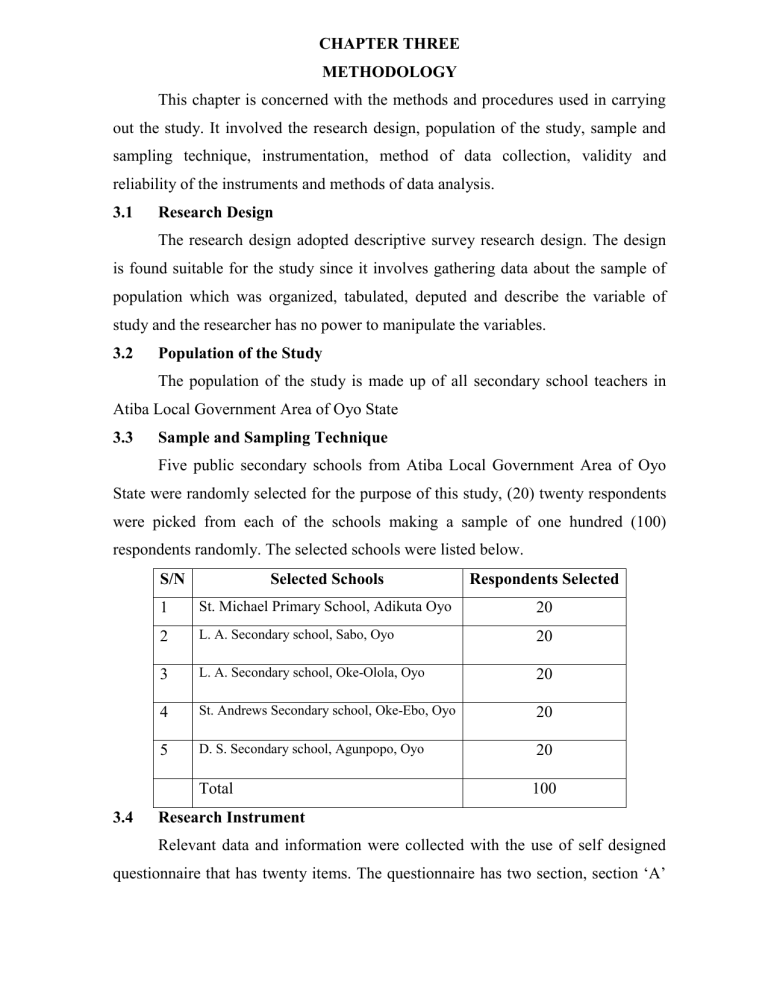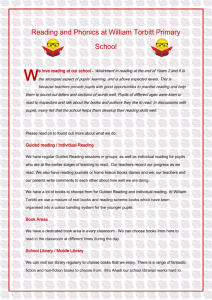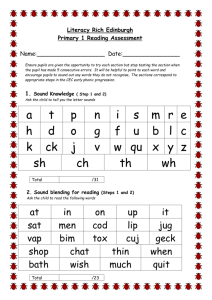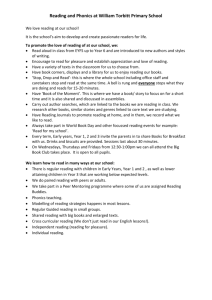
CHAPTER THREE METHODOLOGY This chapter is concerned with the methods and procedures used in carrying out the study. It involved the research design, population of the study, sample and sampling technique, instrumentation, method of data collection, validity and reliability of the instruments and methods of data analysis. 3.1 Research Design The research design adopted descriptive survey research design. The design is found suitable for the study since it involves gathering data about the sample of population which was organized, tabulated, deputed and describe the variable of study and the researcher has no power to manipulate the variables. 3.2 Population of the Study The population of the study is made up of all secondary school teachers in Atiba Local Government Area of Oyo State 3.3 Sample and Sampling Technique Five public secondary schools from Atiba Local Government Area of Oyo State were randomly selected for the purpose of this study, (20) twenty respondents were picked from each of the schools making a sample of one hundred (100) respondents randomly. The selected schools were listed below. S/N Selected Schools Respondents Selected 1 St. Michael Primary School, Adikuta Oyo 20 2 L. A. Secondary school, Sabo, Oyo 20 3 L. A. Secondary school, Oke-Olola, Oyo 20 4 St. Andrews Secondary school, Oke-Ebo, Oyo 20 5 D. S. Secondary school, Agunpopo, Oyo 20 Total 3.4 100 Research Instrument Relevant data and information were collected with the use of self designed questionnaire that has twenty items. The questionnaire has two section, section ‘A’ and ‘B’. section ‘A’ sought for personal data of the respondents like name of school, gender, qualification, professional status and age while section ‘B’ consists of item that sought for the impact of learning English through Jolly phonics at the lower basic classes in selected secondary schools in Atiba Local Government Area of Oyo State. 3.5 Validity of the Research Instrument The research instrument was given to project supervisor for scrutiny to ascertain its construct and face validity. The comments made by the supervisor were also noted some items were modified some were removed some were added to the final draft of the questionnaire. 3.6 Reliability of the Instrument The test re-test method will be employ in establishing the reliability of the instrument. Scores of the same group of people from two administrations of the same test will correlate. The data collected will be subject to statistical tests using the simple percentage and t-test to establish the reliability coefficient. 3.7 Administration of the Instrument The researcher was personally involved in the distribution and administration of the instrument, the researcher went to the five samples schools and sampled the respondents used for the study. She gave the respondents some time to respond to the instrument. She later retrieved the questionnaire and cross checked if they were correctly filled. 3.8 Methods of Data Analysis Based on the data collection after the questionnaires were administered, mean and standard deviation was considered appropriate and used for the analysis of the research questions. EMMANUEL ALAYANDE COLLEGE OF EDUCATION SCHOOL OF SECONDARY EDUCATION (LANGUAGES PROGRAMME) DEPARTMENT OF ENGLISH IMPACT OF LEARNING ENGLISH THROUGH JOLLY PHONICS QUESTIONNAIRE (ILETJPQ) (STUDENTS’ QUESTIONNAIRE) Dear Respondent, This is a questionnaire designed to collect information on the impact of learning English through jolly phonics at lower basic classes in secondary school in Atiba Local Government Area of Oyo State. The study is purely on academic exercise. Hence, the information volunteered will be confidential. Kindly provide appropriate information on the questionnaire. Thank you SECTION A: PERSONAL INFORMATION Introduction: Please supply the following data which are needed for research. All information supplied here will be treated with as confidential. Thanks for your time. Sex: Male ( ), Female ( ) Age: 10-15 ( ), 16-20 ( ), 21 and above ( ) Class: SS 1 ( ), SS 2 ( ), SS 32 ( ) SECTION B Instruction: The key for the letter are provided as probable solution. In your own response tick () the box you find most appropriate. The key to the letter are: SA - Strongly Agree A - Agree D - Disagree SD - Disagree S/N 1 2 3 NATURE OF JOLLY PHONICSFACED BY PUPILS SA A D SD IN ENGLISH LANGUAGE Jolly phonics help pupils in lower classes to assimilates easily in learning oral English Jolly phonics brings more interaction between pupils in lower classes in secondary school and their teacher Using jolly phonics by pupils in English classes enhance them to read English story books in a near future 4 When using jolly phonics by pupils work out the sounds in words very well 5 Jolly phonics will help children adapt quickly when children shift suddenly from a familiar local language FACTORS RESPONSIBLE FOR PHONIC DIFFICULTIES 1 Lack of knowledge by teacher teaching phonics is a factor which contributes to pupils’ poor reading 2 Lack of explicit and systematic instruction and adequate practice with phonics and decoding make it difficult for children to adapt to phonic 3 Instruction that prioritizes alternative "cues" for reading words, such as predicting the word based on the first letter or the picture affect pupils in phonic 4 The most common cause of difficulties in acquiring early word reading skills is weakness in the ability to process the phonological features of language 5 Deficits in the development of phoneme awareness skills by pupils goes a long way to affect their reading ability STRATEGIES TO ENHANCE THE PHONIC DIFFICULTIES 1 Use hand gestures to help the learners remember the letter sounds 2 Deliberate situations should be encourage/organized for students to make use of language context 3 Teacher should teach pupils the letter sounds by asking the learners to repeat the sounds orally. 4 There should no or limitation of using mother tongue among students in order to adapt to the use of good English 5 Pupils should be taught how to enunciate each letter sound OTHER REMEDIAL INTERVENTIONS PROPOSED TO STRENGTHEN PHONICS 1 Teacher need to teach pupils how to blend the letter sounds orally 2 There is need to teach pupils how to blend the letter sounds with the help of alphabet cards 3 Teaching blending through kinaesthetic activities (e.g.; arm blending) is needed 4 Teachers should always bear the pain and anxieties of attending to each pupil and give him or her the needed assistance when appropriate so that they can all benefit from lessons 5 A different approach or technique and use of varied models should be adopted by teachers in the teaching and handling of phonic especially at the secondary level





